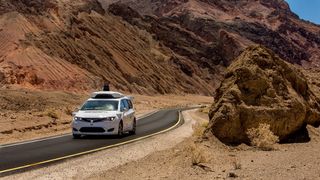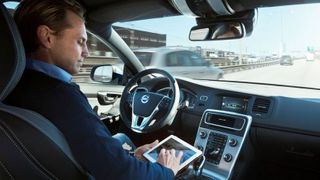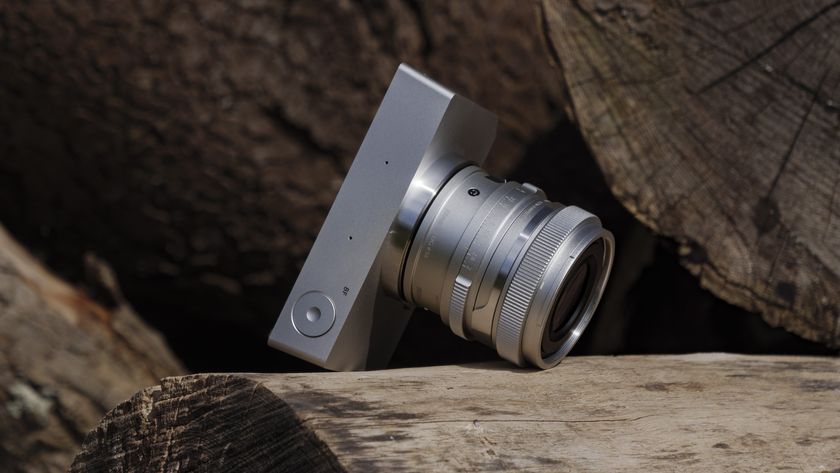Waymo: everything you need to know from Google until now
Get up to speed with the driverless car program

6 million: number of miles driven on public roads
600: number of minivans in the Waymo fleet
20,000: number of Jaguar I-Paces to be built in the first two years of production
'Thousands': number of additional minivans recently purchased from Fiat Chrysler Automobiles
25: number of US cities where Waymo has driven
2.7 billion: number of virtual miles driven
20,000+: number of driving scenarios in Waymo's database
Update: Want to know what Waymo's new Jaguar I-Pace self-driving car looks like in real life?
You've come to the right place as we spotted the all-electric, compact, self-driving SUV at Google IO 2018.
It's a sleek and stylish vehicle that leaves a lasting impression. You almost don't even notice the black orb that crowns its roof or white boxes protruding from its sides.
This looks like an everyday car, and that's a good thing for the driverless car industry.
Google also revealed during IO that Waymo vehicles have drive 6 million miles on public roads in addition to the hundreds of millions of miles driven in virtual environments.
Take a peek at our photos from Google IO 2018 below!




Original article continues below...
Get daily insight, inspiration and deals in your inbox
Sign up for breaking news, reviews, opinion, top tech deals, and more.
Self-driving cars. You've heard of 'em, right? One company at the forefront of the movement is Waymo. While not necessarily a household name, you've no doubt heard about the company that started the project: Google.
Though it was only spun out on its own just over a year ago, the expertise on which Waymo is building has been around for nearly a decade. Fast-forward to today, and Waymo is leading the self-driving car pack, including in miles driven and rates of disengagement, or when a human driver has to take over for the self-driving technology.
Waymo is working towards a lofty goal: launch a self-driving ride-hailing service this year. Can it pull it off? That remains to be seen.
But let's back up. Just what, exactly, is Waymo? Is it available where you live? Will you be able to hail a Waymo self-driving car when the service launches? Here's a breakdown of everything you need to know about Waymo.
What is Waymo and what's it trying to do?
Waymo was formerly Google's self-driving car project and officially came into existence in December 2016, when it was announced as a subsidiary of Alphabet, Google's parent company.
Waymo considers itself a self-driving technology company, rather than a self-driving car company. It does, however, have thousands of self-driving cars in its fleet, equipped with lidar and other sensors that allow for driver-free operation.
Waymo's mission is fairly straightforward: "make it easy and safe for people and objects to move around."
Waymo envisions a future where there are fewer accidents caused by distracted, impaired and generally fallible human drivers, as well as reduced traffic and greater general ease to getting around. Waymo's tech, then, could show up in personal vehicles, ridesharing services, trucking or even in public transportation.
What kind of cars are we talking about here?
When it started, Waymo made it clear that it wouldn't build its own vehicles for mass production and distribution, but rather would work with established car makers that would integrate its self-driving tech into their vehicles. Fiat Chrysler Automobiles (FCA) is just such a partner; Waymo's fleet already consisted of 600 Pacifica Hybrid minivans, and Google recently bought 'thousands' more.
You may remember those cute koala-like cars without a steering wheel or pedals that caused quite a stir a few years ago?
This 'Firefly' prototype (seen in the video above) has driven on public roads, but it's just that: a prototype meant to showcase and test Waymo's tech, rather than serve as a final product.

What Waymo has become known for are its minivans. Specifically, the Chrysler Pacifica Hybrid supplied by long-standing partner FCA.
While they may look like your average minivan, save for the lidar rig on top, these minivans have a fully-integrated hardware suite developed by Waymo that allows for complete self-driving. This hardware includes lidar, radar and vision systems that allow for autonomous operation.
According to Waymo CEO John Krafcik, Waymo's sensors provide vehicles with a 360-degree view of the world around them. Lasers (lidar) 'see' objects in 3D and can detect objects up to 300 meters away. What's more, Waymo radar can 'see' underneath and around vehicles, picking up objects a human driver would otherwise miss.
In a recent blog post, Waymo also detailed that its vehicles use machine learning to identify and respond to emergency vehicles or pull off tricky driving maneuvers, such as unprotected left turns.
But while minivans have, in some ways, become the face of the Waymo fleet, in March 2018 the line got a premium boost when it was announced that Jaguar I-Pace SUVs would be joining the cause.
The I-Pace is Jaguar's first electric car, and thanks to the partnership with Waymo, 20,000 should be built in the first two years of production. These will be available to use in Waymo's driverless car service when it launches in the US.
Where is Waymo?
Waymo is currently exclusive to the US. Its primary testing grounds are Mountain View, California; Austin, Texas; Kirkland, Washington; and the metro Phoenix area in Arizona. Waymo has been driven in 25 US cities all told, and is coming to Atlanta soon.
This has allowed Waymo to test its self-driving tech in a variety of conditions, such as hills, extreme heat, rain and cold.

Fairly lax regulations have turned Arizona into an important and relatively wide-open testing ground for Waymo. It's here that Waymo is conducting test drives where its vehicles operate without someone in the driver's seat, achieving Level 4 autonomy.
In addition to these tests, Waymo also runs an early rider program in the Phoenix area. This is pretty much what it sounds like; select riders can use Waymo cars to travel to places they go regularly, like work and school. These riders provide feedback on the experience.
Waymo's recent fleet expansion and tests with riders are in preparation for the launch of the company's ride-hailing service, slated to begin operation this year.
The first phase of the plan is to launch the service in Phoenix with minivans it's already tested, according to Engadget. The service will eventually expand to more US cities, and Waymo's recent order of 'thousands' of minivans from FCA will support this effort. Just know that you won't actually be alone with the self-driving car; an employee will ride along with you in case something goes awry.
Is Waymo safe?
Safety is the number one concern with self-driving cars. Waymo is not without accidents, though the majority of incidents involved a car bumping into a Waymo vehicle from behind or otherwise crashing into the Waymo car.
One accident in September 2017 was caused by a Waymo car, though the human driver had taken over the vehicle and swerved into the next lane to avoid an object in the road, reports SFGate. The incident raises an interesting question: would the situation have been different had the car stayed in self-driving mode?
Prior to Waymo's official existence, Google's self-driving cars were involved in a number of accidents. The number reported in 2015 was 12 accidents over the previous six years and more than 1.7 million miles driven, according to the Los Angeles Times.
In all of those instances, Google said its self-driving cars weren't at fault (eight of the 12 were rear-endings). In one case, a Google employee was in control of the vehicle when the crash occurred.
This relatively clean accident record was tarnished with Google's first at-fault crash in February 2016. In this case, the self-driving car hit the side of a bus while attempting to move into the center of a lane.
The car had stopped due to sandbags on the side of the road and began to move into the lane when the bus approached. The car stayed in self-driving mode throughout, predicting the bus would stop while it continued its turn. That obviously didn't happen.
In May 2018, a self-driving Waymo minivan was involved in an accident in May 2018, in Chandler, Arizona.
In this case, Waymo’s AI was not to be blamed for the incident.
According to the Chandler Police department, a Honda sedan ran a red light, then drove into oncoming traffic to avoid another car in the intersection, swerving directly into the Waymo Chrysler minivan’s path. The human driver behind the wheel suffered minor injuries.
Footage of the crash, which you can view above, shows the vehicle run the red light then cross into oncoming traffic and hit the Waymo minivan.
Local police initially claimed that Waymo’s car had been in autonomous mode at the time of the crash, but later affirmed Waymo’s assertion that the car had been in manual mode. They stressed from the start that neither Waymo nor the driver of the driver were considered at fault for the incident.

Another area to look at is disengagement. Among the self-driving cars on the road that report disengagements, or when a human takes over for self-driving tech, Waymo has the fewest.
In its most recent report submitted to the California DMV for its tests in the state, Waymo said its disengagement rate dropped from 0.20 per thousand miles to 0.18. Disengagements can happen for a number of reasons, such as someone else driving recklessly or a hardware discrepancy. According to Waymo, "The vast majority of disengagements are not related to safety."
According to stats pulled together by The Information's Amir Efrati, Waymo had the fewest number of disengagements per 1,000 miles driven by self-driving cars. Waymo also had the most miles driven in the reporting period (December 2016 - November 2017).
Waymo's competitors
If you're wondering whether Waymo has competition, the answer is simple: yes.
Its biggest competition, on a few fronts, is Uber. Waymo and Uber were recently locked in a legal battle over allegations that a former Google employee stole 14,000 files from Waymo detailing proprietary information, particularly about Waymo's custom lidar circuit board. The employee, Anthony Levandowski, founded an autonomous truck company called Otto that Uber bought. Uber also placed Levandowski in charge of its self-driving efforts.
Had it not been for a supplier accidentally copying Waymo on an email with an attachment showing Uber's lidar system, we may not have faced the biggest lawsuit to hit the nascent self-driving sector. The trial was short-lived, however, as Waymo and Uber announced a settlement on February 9, 2018. While the two are committing to making sure no Waymo trade secrets end up in Uber's self-driving cars, competition between the two is still fierce.

Beyond Uber, there are dozens of companies working on self-driving cars and related technologies, including traditional car makers. Many aim to have their autonomous vehicles on the road in just a few years.
Hyundai, for one, wants to have self-driving cars on the road by 2021, while GM is deploying test vehicles in New York City. Ford, VW, Mercedes Benz, Tesla, Nissan, Nvidia, and, yes, even Apple, are just a few of the names currently testing self-driving vehicles.
Despite the lanes getting a bit crowded, Waymo is comfortably ahead of the competition when it comes to self-driving cars. We won't be zipping around in these driverless machines tomorrow, but Waymo is well on its way to making self-driving cars an everyday reality.
- Driverless cars explained: everything you need to know about self-driving cars
Michelle was previously a news editor at TechRadar, leading consumer tech news and reviews. Michelle is now a Content Strategist at Facebook. A versatile, highly effective content writer and skilled editor with a keen eye for detail, Michelle is a collaborative problem solver and covered everything from smartwatches and microprocessors to VR and self-driving cars.












